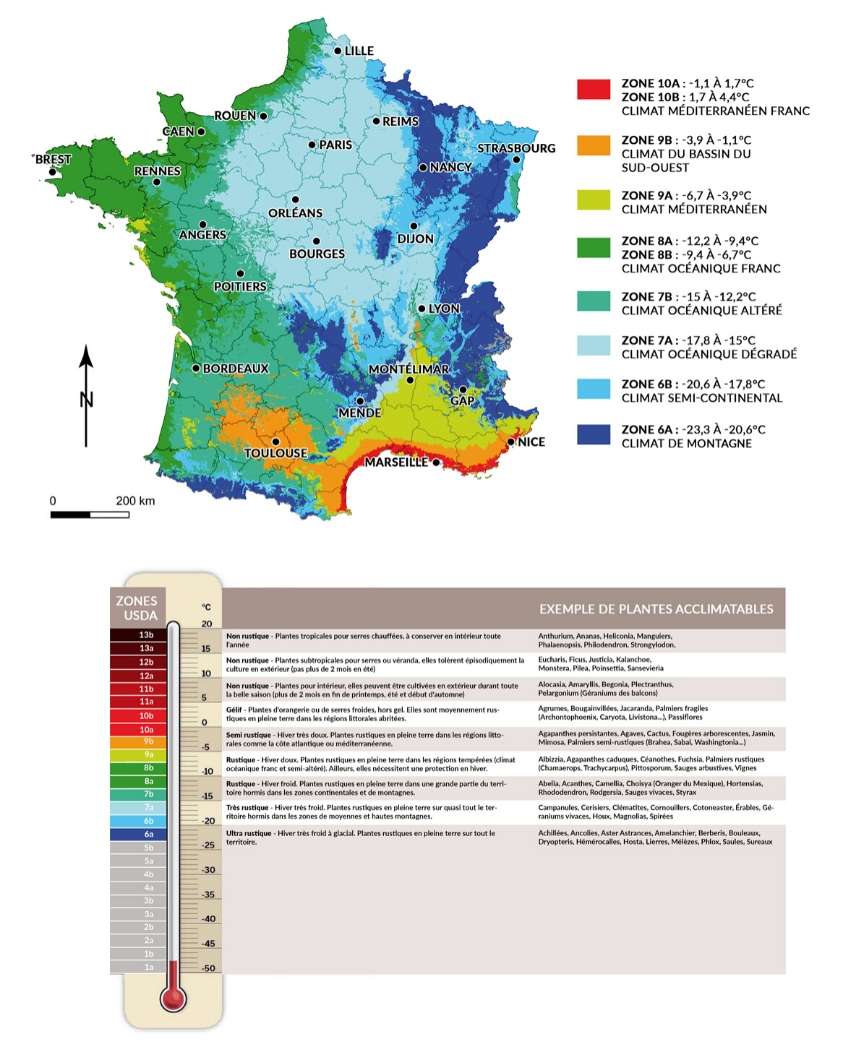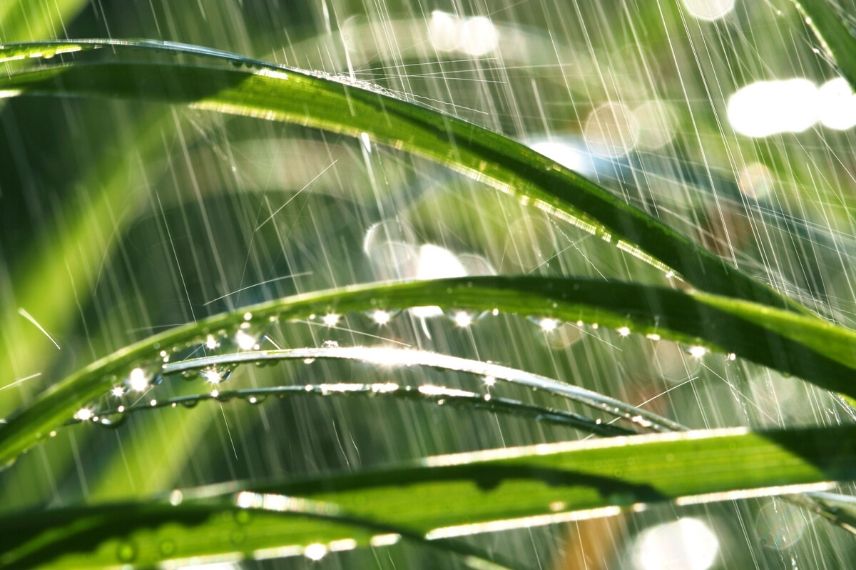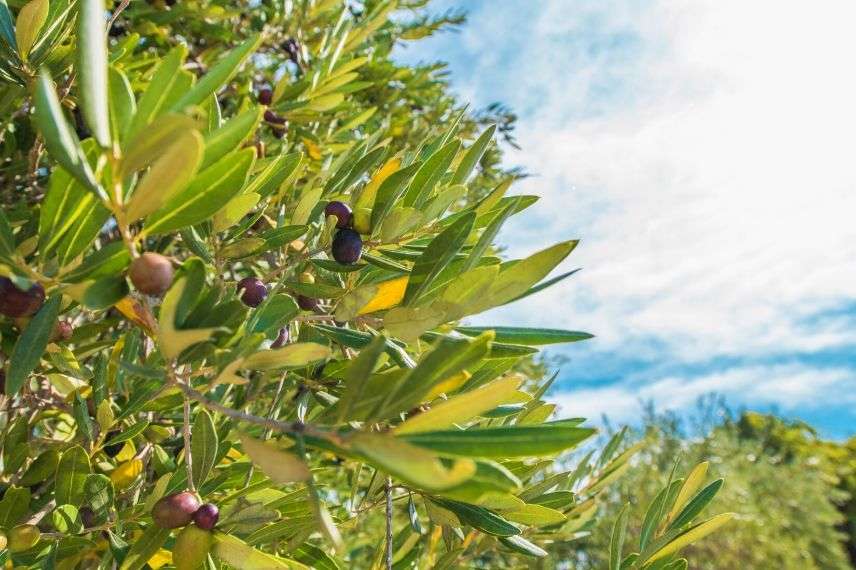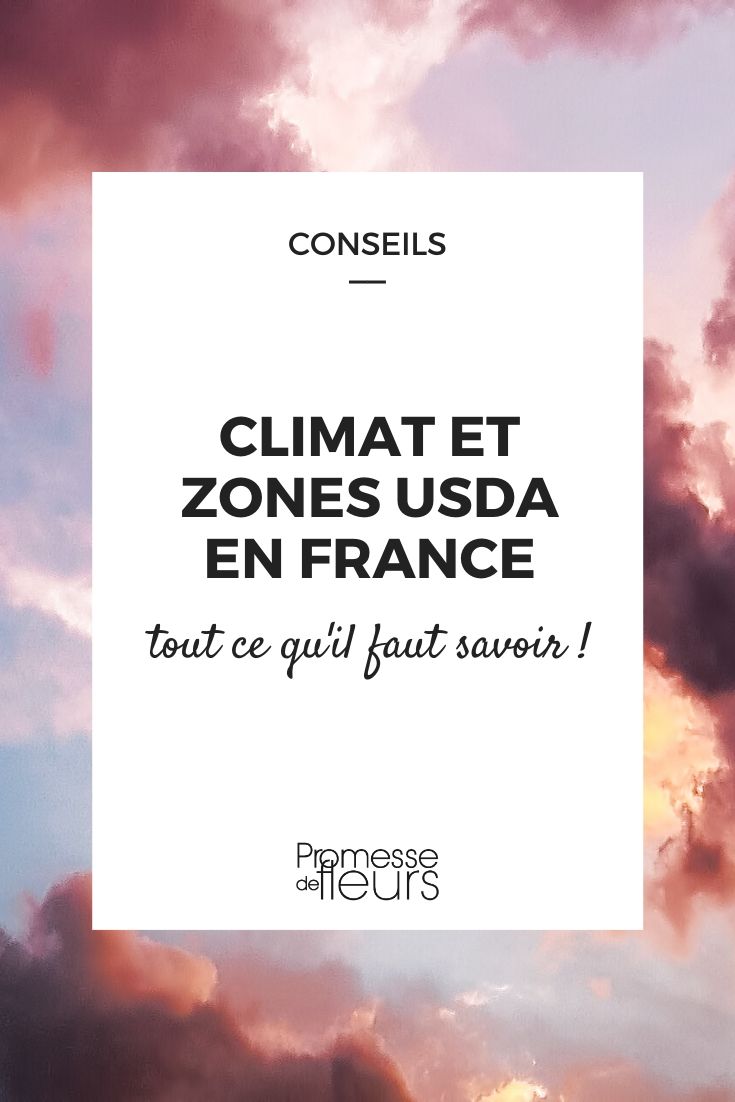
Climate zones and USDA zones in France
Get your bearings to choose plants wisely
Contents
France is well known for its extraordinary diversity of landscapes and climates. Indeed, although enjoying an overall temperate climate, our country shows marked regional differences in temperature and rainfall… In nature, this results in quite specific flora and, in gardens, in the need to choose suitable vegetation: plants that are particularly hardy, cold-resistant or that perform better in mild, humid climates…
This information appears in all our plant sheets but understanding it is not always easy because we use USDA zones.
So I suggest we take stock of climate zones in France and how they translate into USDA zones, to help choose plants suited to the climate of your garden!
Climate map of France + USDA zones

Read also
Hardy plants and hardinessUSDA hardiness zones
The concept of USDA zones is American, it was created by the United States Department of Agriculture (U.S. Department of Agriculture, hence the term USDA). It is a geographical division into 26 isothermal zones based on the average of minimum temperatures over the last 20 years. In practical terms, these indicators represent the ‘probable minimum temperature’ your region will experience in winter, which is fundamental when discussing hardiness!
This approach to defining hardiness zones is used in many countries, including France. USDA zones have the advantage of being fairly precise and are widely used worldwide. The scale includes 26 levels but in France only 10 are used, from zone 6a to zone 10b.
Summary table :
| Type of climate | USDA zone |
| Type 1 Montane climate | Zone 6a: -23.3 to -20.6°C |
| Type 2 Semi-continental climate and climate of montane margins | Zone 6b: -20.6 to -17.8°C |
| Type 3 Modified oceanic climate of central and northern plains | Zone 7a: -17.8 to -15.0°C |
| Type 4 Altered oceanic climate | Zone 7b: -15.0 to -12.2°C |
| Type 5 True oceanic climate | Zone 8a: -12.2 to -9.4°C |
| Zone 8b: -9.4 to -6.7°C | |
| Type 6 Altered Mediterranean climate | Zone 9a: -6.7 to -3.9°C |
| Type 7 South-West Basin climate | Zone 9b: -3.9 to -1.1°C |
| Type 8 True Mediterranean climate | Zone 10a: -1.1 to 1.7°C |
| Zone 10b: 1.7 to 4.4°C |
Discover other Climbers
View all →Available in 0 sizes
Available in 0 sizes
Available in 0 sizes
Available in 2 sizes
Available in 3 sizes
Available in 2 sizes
Available in 3 sizes
Available in 2 sizes
Available in 2 sizes
Available in 0 sizes
Type 1: Mountain climates - USDA Zone 6a
Mountain climates are fairly diverse and distributed in almost all of France: Pyrenees, Massif Central, Alps, Jura, Morvan, Ardennes but also, at lower altitudes, the short stems of bulb to the east of Champagne and part of Lorraine and Franche‑Comté…
In these geographical areas, note the following :
- a high number of days and a high cumulative total of precipitation (rain, snow…)
- mean temperature below 9.4°C with more than 25 days during which minimum temperature was below -5°C and fewer than 4 days with maximum temperature above 30°C.
- Interannual variability of July precipitation and of winter and summer temperatures is maximal.
→ This climate corresponds to USDA hardiness zone 6a (observed minimum temperatures: -23.3 to -20.6°C)
Read also
10 very hardy, frost-resistant treesType 2: semi-continental climate and climate of montane margins - USDA zone 6b
Type 2 climate is an intermediate climate between montane climates and climates of type 3, 4 and 8. Area covered by this climate comprises montane peripheries and large areas of Burgundy, Lorraine and Alsace.
In these areas :
- temperatures are milder than in mountains (but, at equal altitude, colder than elsewhere),
- precipitation is slightly lower and less frequent,
- a low ratio between autumn and summer precipitation is observed
→ This climate corresponds to USDA hardiness zone 6b (recorded minimum temperatures: -20.6 to -17.8°C)

Type 3: degraded oceanic climate of the central and northern plains - USDA zone 7a
Type 3 climate covers the whole Paris Basin, extending southwards (middle Loire valley, northern Massif Central and Saône valley).
The climate remains oceanic but with marked gradations :
- temperatures are intermediate (around 11°C annual average, between 8 and 14 days with a temperature below -5°C).
- precipitation is low (less than 700 mm of annual total), especially in summer, but rain falls on average on 12 days in January and on 8 in July, average values for France as a whole.
- interannual variability of precipitation is minimal while that of temperatures is high.
→ This climate corresponds to USDA zone 7a (observed minimum temperatures: -17.8 to -15°C)
Type 4: Modified oceanic climate - USDA Zone 7b
Type 4 climate, altered oceanic climate appears as a transition between oceanic (type 5) and degraded oceanic (type 3). Between Nord-Pas-de-Calais and Normandy, it forms a narrow strip while to the west this transition widens to more than 150 km. This climate also affects the south-west of the Massif Central, from Dordogne to Aveyron and the northern Pyrenees.
Characteristics:
- Mean annual temperature is fairly high (12.5°C) with a low number of cold days (between 4 and 8/year) and a relatively high number of hot days (between 15 and 23/year).
- Annual thermal amplitude (July–January) is close to minimum and interannual variability is average.
- Precipitation, average annual total (800–900 mm), falls mainly in winter, with summer fairly dry.
→ This climate corresponds to USDA zone 7b (observed minimum temperatures: -15 to -12.2°C)
Type 5: True oceanic climate - USDA zones 8a and 8b
Oceanic climate occupies a thin strip along the North Sea and all of Normandy, Brittany, Vendée and Charentes.
In these areas :
- Temperatures are moderate and very uniform: annual amplitude (less than 13 °C difference between July and January), number of cold days (less than 4) and hot days (less than 4), and interannual variability are minimal.
- Precipitation is annually abundant (just over 1000 mm) and frequent in winter (more than 13 days in January).
- Summer is also rainy (8–9 days in July) but totals are low.
- Oceanic climate is also characterised by strong interannual variability of winter precipitation.
→ This climate corresponds to USDA zones 8a and 8b (observed minimum temperatures: -12.2 °C to -6.7 °C)

Type 6: Altered Mediterranean climate - USDA zone 9a
The altered Mediterranean climate occurs mainly over the Alps and southern Pre-Alps, encompassing most of the Alpes-de-Haute-Provence and Drôme departments. Some remnants are also found on the left bank of the Rhône, at the level of Ardèche and in the form of a narrow strip to the west, between Pyrénées-Orientales and Hérault.
Characteristics:
- an elevated mean annual temperature, with a limited number of cold days and hot days of 15–23 per year.
- interannual variability of July minimum temperatures: summer is repeatedly warm from one year to the next.
- a mean annual precipitation total (800–950 mm) but not distributed homogeneously.
- autumn and winter, wet and highly variable from year to year, are opposite to summer, which is dry and stable relative to the 1971–2000 norm.
→ This climate corresponds to USDA zone 9a (observed minimum temperatures: -6.7 to -3.9°C)
Type 7: Climate of the South-West Basin - USDA Zone 9b
This type of climate pertains to a geographically disparate zone, straddling several regions (Aquitaine, Languedoc) and centred on the middle Garonne basin, referred to for convenience as «South-West Basin».
It is characterised by :
- an annual average temperature that is high (above 13°C) and a high number (> 23) of hot days, while days with frost below -5°C are rare.
- a large annual temperature range (15 to 16°C) and low interannual variability of winter and summer temperatures.
- Precipitation is low in annual total (less than 800 mm). Precipitation is more frequent in winter (9–11 days) than in summer (fewer than 6 days), but totals are somewhat higher in summer. This distribution indicates that precipitation intensity is low in winter (oceanic precipitation) and higher in summer (storm disturbances coming from Spain or the Bay of Biscay). Interannual variability of precipitation is moderate.
→ This climate corresponds to USDA zone 9b (observed minimum temperatures: -3.9 to -1.1°C)

Type 8: True Mediterranean climate - USDA zones 10a and 10b
This climate occupies a band of roughly one hundred kilometres around the Mediterranean Sea, from the Pyrenees to the Var. Beyond that, in the Maritime Alps, the Mediterranean climate narrows so much that it appears only sporadically within the alpine valleys.
The climatic characters are very marked, more so than in any of the seven previous climates.
- Annual temperatures are high, cold days are very rare and hot days frequent.
- The seasonal amplitude is large (more than 17°C between July and January) while these characters are very stable from one year to the next.
- The very high ratio between autumn precipitation and summer precipitation (> 6) is the main character of this climate. Annual total precipitation is low with an arid summer but a fairly wet winter despite a low number of rainy days. These characters are also stable from year to year.
→ This climate corresponds to USDA zones 10a and 10b (observed minimum temperatures: -1°C to +4.4°C)
Find out more
Discover our advice sheet: Hardy plants and hardiness.
- Subscribe!
- Contents














































Comments